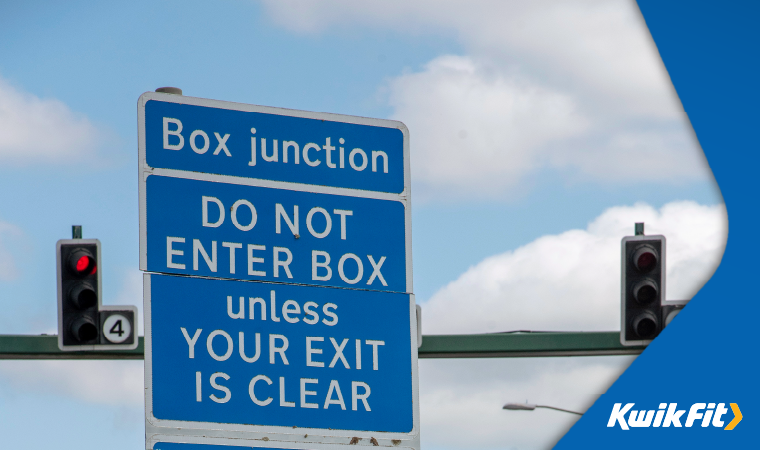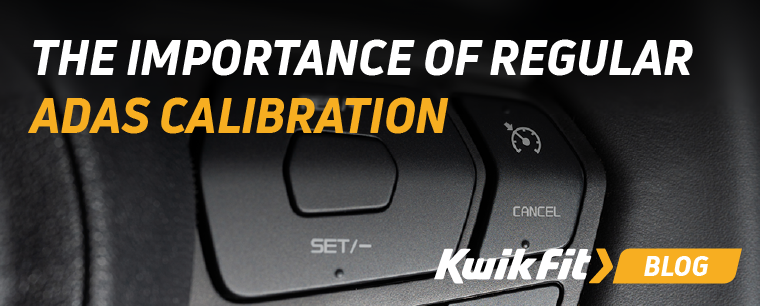Understanding The UK’s Yellow Box Junction Rules
Kwik Fit | Monday 14th April 2025 10:17am

Although occasionally worn down and hard to read, road markings are some of — if not the — most crucial signage for motorists. Designed to give drivers concise messages to keep them safe and in the correct position on the road, the markings beneath your tyres are essential forms of communication.
One of the most prominent road markings is the yellow box junction. Used to prevent motorists from blocking crucial junctions and causing traffic pile ups, yellow box junctions are critical to keeping cars flowing smoothly.
Read on for essential information about the rules surrounding these junctions, and how to avoid any confusion when navigating them.
What is a yellow box junction?
A yellow box junction (also known as just a “box junction”) is a type of road marking that prevents vehicles from waiting across junctions and blocking the flow of traffic. Shaped like a large box with hatching (a criss-cross pattern), these markings prevent queueing drivers from covering road exits and entrances.
Yellow boxes are typically used in busy areas where there is likely to be congestion. They’re designed to prevent vehicles from entering an intersection unless they can make it out the other side without blocking any of the junction.
Other yellow hatchings
If you pay attention to your road markings, you might also see yellow boxes in other locations. Yellow boxes are often placed outside of fire stations or ambulance bays to keep exits free from loitering or parked vehicles, so that emergency vehicles can be deployed quickly.

Yellow box junction rules
Yellow boxes have some of the most inflexible rules when it comes to road markings, so it’s essential you learn what you can and can’t do — or else risk landing yourself with a fine!
The one golden (yellow box) rule is: Drivers should never stop in a yellow box, as this is considered an offence. Of course, the rules in practice are much more complicated than that, and there are a couple of exceptions.
Below we’ve covered all the scenarios in which you might interact with a yellow box junction so that you’re covered.
Basic rules
Rule 174 of the Highway Code covers box junctions, and the official advice is “you MUST NOT enter the box unless you can cross over it completely without stopping.” Breaking this down further: you should not enter a yellow box junction unless your exit road or lane is clear and you can fully emerge out the other side of the box. The only exception to the rule is when you turn right.
Turning left (& going straight)
If you’re approaching a yellow box junction, but you’re simply driving straight through or doing an easy left turn, you need to make sure that you can safely leave the box before entering. So, when approaching, check your onward or left-hand exit and gauge whether there’s space enough for you to enter and completely exit the box before pulling away.
- If the traffic ahead of you is flowing freely through the box and out the other side (and you believe you can also fit), then drive onwards.
- If there is a queue of stationary traffic in the road you want to join, wait until there is space for your car to join them on the other side of the box before driving on. Oftentimes, gaps appear in slow-moving traffic and drivers notice late before “catching up” and making more room, so wait your turn.
Turning right
Turning right at a box junction has a slightly different set of rules. If you’re turning right, you are allowed to stop in a yellow box. Here’s why:
- When turning right, check that your exit road is clear.
- If your exit is clear, you may then need to wait for oncoming traffic to halt before actually making the turn.
- If this is the case, then you are permitted to pull forwards into the box and wait before making the turn.
Just as it's sometimes necessary to pull into the middle of the road and wait for oncoming traffic to stop when turning right at a regular junction, yellow boxes make similar allowances. If the junction is controlled by traffic lights, you may need to wait for the green arrow to safely turn out of the box. If the traffic light turns red while you are still trying to make your right turn from inside the box, you can still proceed ahead — as long as the traffic from the other direction hasn’t started.
Note: It can be easy to fall into the trap of following the vehicle in front of you into the yellow box if you are both turning right. However, just because there’s space for them, does not necessarily mean that there will be time enough for your vehicle to turn before traffic begins from the other direction.

What happens if you get stuck in a yellow box junction?
Getting stranded in the middle of a box junction is against the law, and a major danger and inconvenience to yourself and others. That’s why we strongly suggest only entering a yellow box junction box if it’s certain that you can either leave straight away or, if turning right, wait briefly for traffic to halt.
Mistakes happen, though, especially if you’re new to driving. So, if you find yourself stuck in a yellow box, don’t be harsh on yourself. Don’t panic, and check all around you before safely pulling away to complete your turn and exit the box.
Can stopping in a yellow box land you with a fine?
In short, yes. If you are caught stopping in a yellow box on camera, then you may well receive a fine letter in the post. Particularly busy junctions often have cameras positioned to point at the yellow boxes to deter drivers from stopping in the hatching.
The cost of yellow box fines differs from county to county — and, of course, how fast you pay up. Most counties charge £70 at the most for box junction violations; however, inner city areas like London can issue FPNs (Fixed Penalty Notices) of up to £130!
Save yourself a headache and a few pounds and make sure that you’re familiar with the yellow box rules.
Yellow box junction dos & don'ts
To simplify things a bit, we’ve created a list of dos and don’ts to help you feel more confident when navigating yellow box junctions.
Do
- Check that there is enough space for your vehicle to move through the yellow box and out the other way before entering.
- Constantly check the flow of traffic and vehicles around you before manoeuvring.
Don't
- Stop in a yellow box junction on the hatchings, unless you are turning right and waiting for traffic to clear.
- Enter a yellow box without checking that you can exit freely.
Stay safe on the roads with Kwik Fit
Staying safe behind the wheel is not just about knowing your road markings and the Highway Code — it’s also about the condition of your vehicle.
Make sure your car is safe and reliable by bringing it to your local Kwik Fit for a Free Vehicle Safety Check. In the meantime, scrub up on your driving law knowledge with our expertly-written blogs and guides.
Any facts, figures and prices shown in our blog articles are correct at time of publication.
Featured Articles
10 things that can affect your stopping distance
Sunday 6th April 2025
From tread depth to tiredness, read on to learn about 10 factors that can impact your braking distance. Stay safe on the roads with Kwik Fit.
What’s The Difference Between An MOT And A Service?
Tuesday 25th March 2025
Car service vs MOT? Learn the core differences between these two crucial types of vehicle maintenance in our informative blog written by experts.
The Importance of Regular ADAS Calibration
Monday 9th September 2024
Want to know why ADAS calibration is important for vehicle safety & performance? Read our blog to learn more about the impacts of not calibrating your ADAS.









